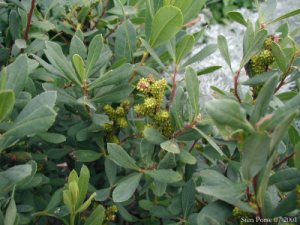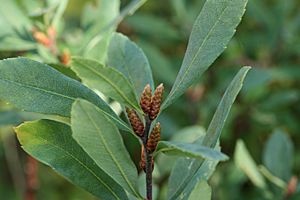Bog-myrtle facts for kids
Quick facts for kids Bog-myrtle |
|
|---|---|
 |
|
| Myrica gale foliage and immature fruit | |
| Conservation status | |
| Scientific classification | |
| Genus: |
Myrica
|
| Species: |
gale
|
| Synonyms | |
|
Gale palustris |
|
Myrica gale is a type of flowering plant that belongs to the Myricaceae family. It grows naturally in Atlantic Europe and parts of northern North America. People often call it bog-myrtle, sweet willow, Dutch myrtle, or sweetgale.
What is Sweetgale?
Sweetgale is a deciduous shrub, which means it's a woody plant that loses its leaves every autumn. It usually grows to be about 1 to 2 meters (3 to 6 feet) tall. Its leaves are arranged in a spiral pattern and are about 2 to 5 centimeters (1 to 2 inches) long. They are shaped like a spoon, wider at the tip and narrower at the base, with slightly crinkled or toothed edges.
The plant's flowers are called catkins. Interestingly, male and female catkins grow on separate plants. This means sweetgale is a dioecious plant, having distinct male and female individuals. The fruit is a small, fleshy fruit with a hard pit inside, similar to a cherry, called a drupe.
Sweetgale often grows in wet, acidic areas like peat bogs. These places don't have much nitrogen, which plants need to grow. To help with this, sweetgale's roots have special actinobacteria. These tiny helpers can take nitrogen from the air and turn it into a form the plant can use. This allows sweetgale to thrive in tough conditions.
How People Use Sweetgale
The leaves of the sweetgale plant have a lovely, sweet, resiny smell. Because of this, people have used it for a long time to keep insects away. Campers, for example, would use it to stop biting bugs from coming into their tents.
Sweetgale is also a traditional part of royal wedding bouquets in some places. You might find it used in perfumes or as a condiment to flavor food.
In Scotland, people have traditionally used sweetgale to ward off tiny biting insects called Highland midges. Today, you can find products like insect repellents and soaps that use sweetgale as an ingredient.
Sweetgale can even grow in a narrow strip along river mouths where the tide goes in and out. It especially likes to grow on logs that have washed ashore. Beavers love to eat sweetgale! Sometimes, you can find small beaver dams in these tidal areas if there's enough sweetgale around. The ponds created by these dams might be completely covered at high tide. But at low tide, they still hold enough water to offer a safe place for fish. If these ponds are deep enough to protect young fish from birds, baby salmon might even grow well there.
A famous story tells that Queen Victoria was given a small sprig of myrtle, which she planted on the Isle of Wight. Her daughter later used some of the plant that grew from it in her wedding bouquet. This started a royal tradition that continues today!
Sweetgale in Food and Medicine
You can dry sweetgale leaves to make tea. Both the small nutlets (fruits) and the dried leaves can also be used to create a seasoning for food.
In north-western Europe (like Germany, Belgium, and the Netherlands), sweetgale was very popular from the Middle Ages until the 16th century. It was used in a mix called gruit to flavor beer. However, it became less common after hops started being used more for political and economic reasons. Today, some brewers are trying out this old method again. In Denmark and Sweden, the plant is often used to make homemade flavored schnaps.
Some native cultures in Eastern Canada have used sweetgale as a traditional medicine. They used it to help with stomach aches, fevers, breathing problems, and liver issues.
In 2007, there were plans to grow more sweetgale in Scotland. The idea was to use its essential oil to treat sensitive skin and acne. It's important to know that women who are pregnant or might be pregnant should not consume this plant.
See also
 In Spanish: Mirto de Brabante para niños
In Spanish: Mirto de Brabante para niños



